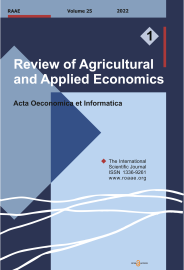KEYWORDS:
willingness to pay; contingent valuation method; Probit; Ethiopia
DOI NUMBER:
10.15414/raae.2021.24.02.37-48
ABSTRACT:
Research background: Crop genetic resource conservation and management requires farmers’ financial and labour contribution. Guizotia abyssinica (locally named as ‘Noug’) is among the oil crops originated from Ethiopia, but currently neglected and poorly managed resource.Purpose of the article: The purpose of this research to understand farmers’ behaviour for conservation program and identify better policy, by examining factors affecting households’ willingness to pay (WTP) for conservation Guizotia abyssinica, and by estimating the aggregate welfare contribution of household for the proposed conservation program in West Shewa, Ethiopia.
Methods: A contingent valuation survey, double bound with an open-ended follow-up question was directed on 160 selected rural households using multi-stage sampling method. Probit model is employed to achieve the purpose of this study.
Findings & Value added: The probit model result showed that factors, such as the amount of credit received, perception of conservation problem, education, frequency of extension contact, proportion of land allocated to Guizotia abyssinica, income from Guizotia abyssinica and income from farm activity have a positive and statistically significant effect on households’ WTP. On the other hand, total livestock holding, age of households, and initial bid have a negative and significant effect WTP. The aggregate welfare contribution household was estimated to be 1,718,059 man-days and 23,260,839 Ethiopian Birr per year. Improving farmer’s extension contact, training farmers, education and solving financial constraints can increase the farmers Guizotia abyssinica conservation in the study area.
Please Cite this Article as:
Gemechu ORDOFA JARA, Wubishet TESHOME GEBRETSADIK, Nesru TEMAM HAJIFATO (2021) Households Willingness To Pay For The Conservation Of Noug: A Case Study. Review of Agricultural and Applied Economics. XXIV (Number 2, 2021): 37-48. doi: 10.15414/raae.2021.24.02.37-48
URL for sharing:
https://roaae.org/1336-9261/doi/abs/10.15414/raae.2021.24.02.37-48
FULL TEXT PDF:
▼ direct download link| view online in fullscreen ▲
References:
▼ direct download link

